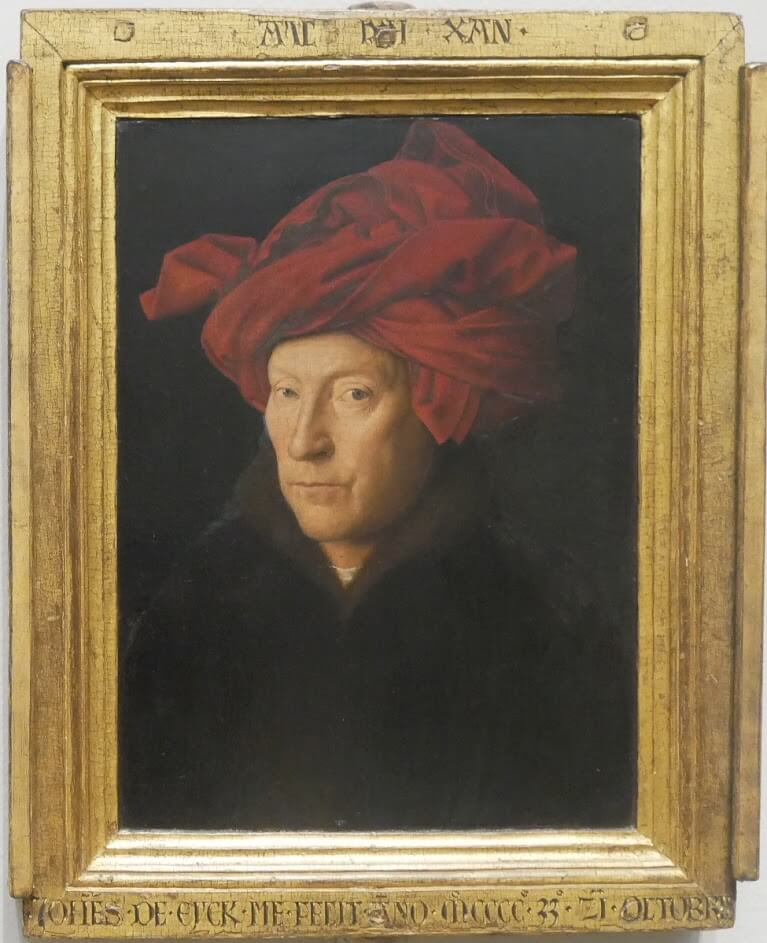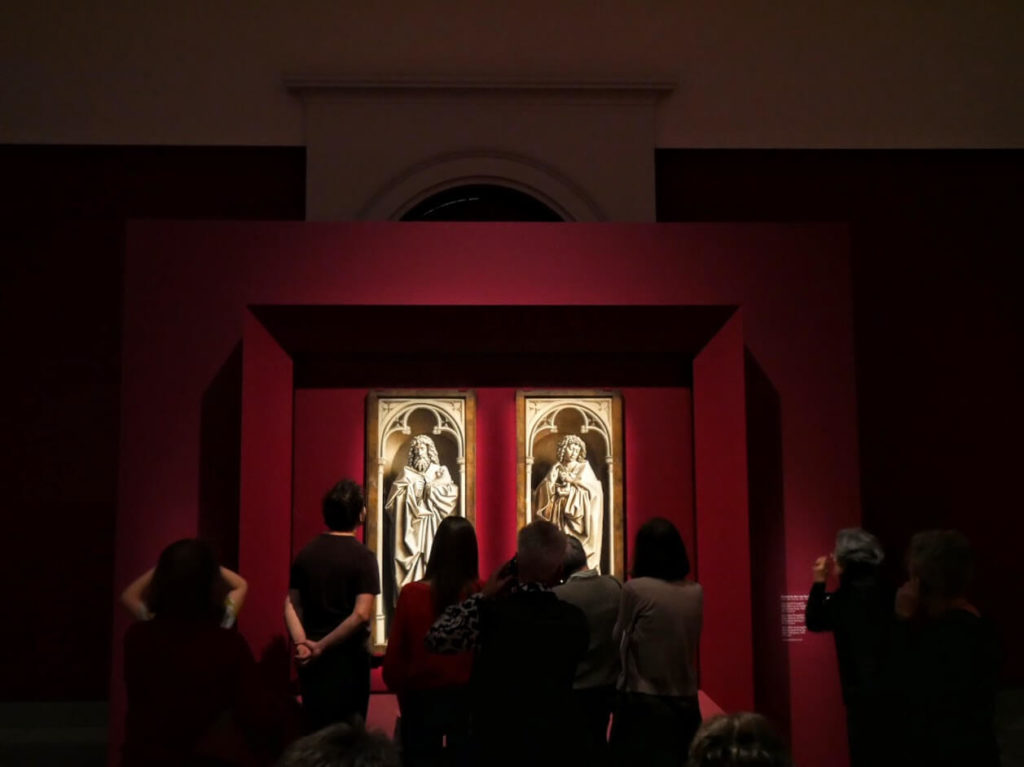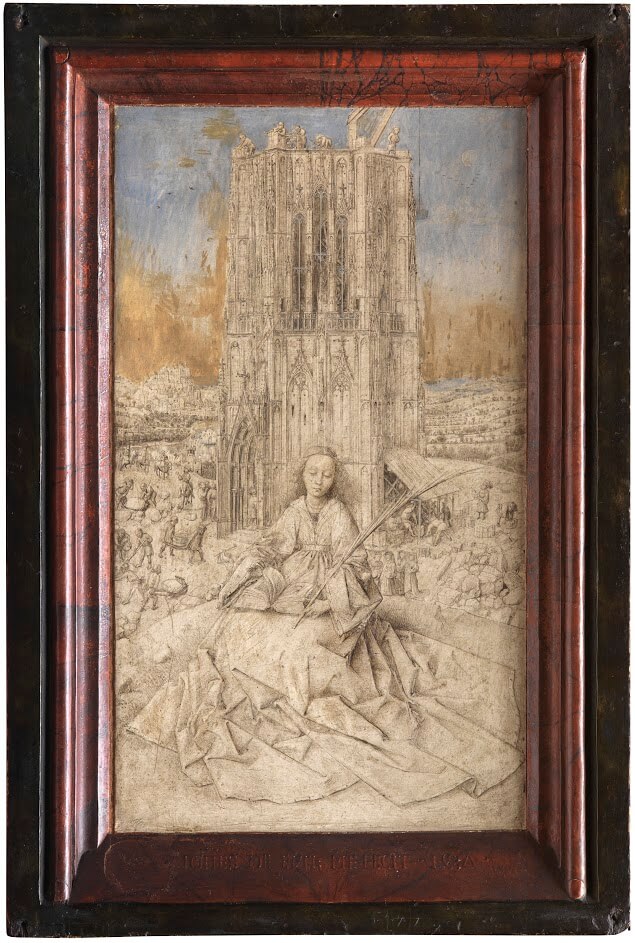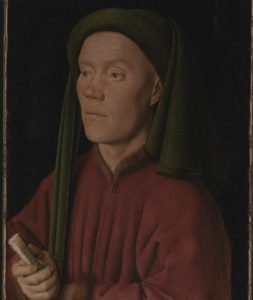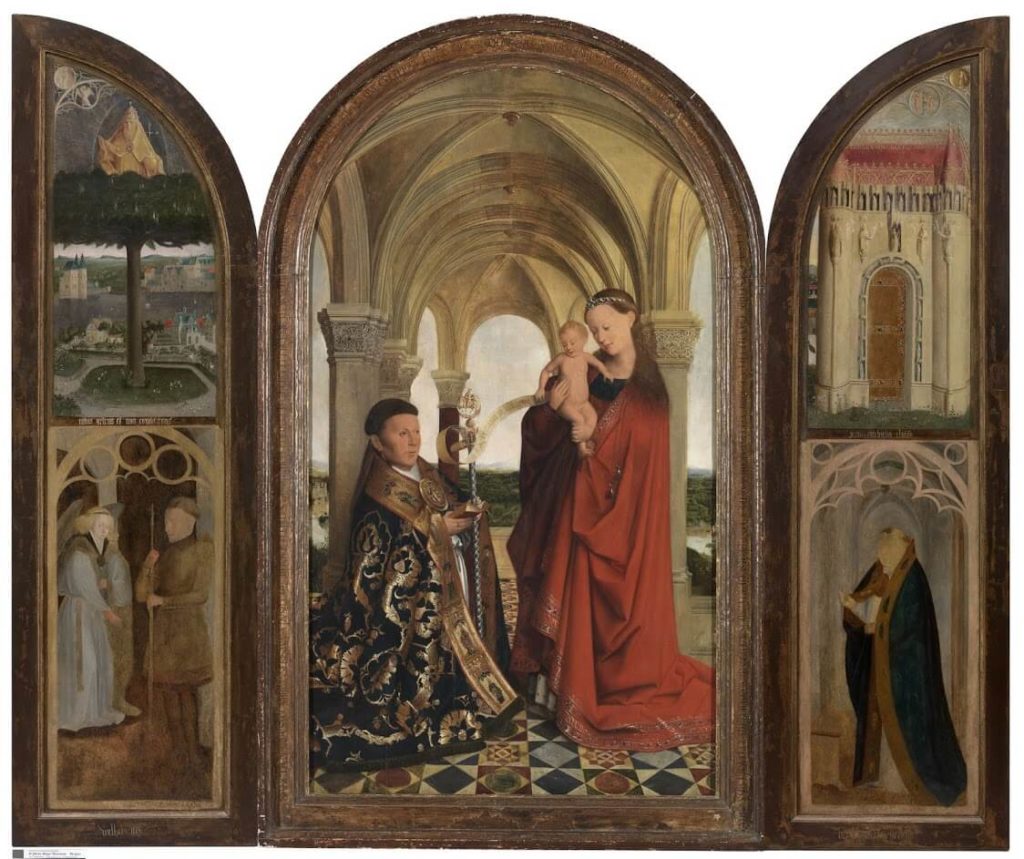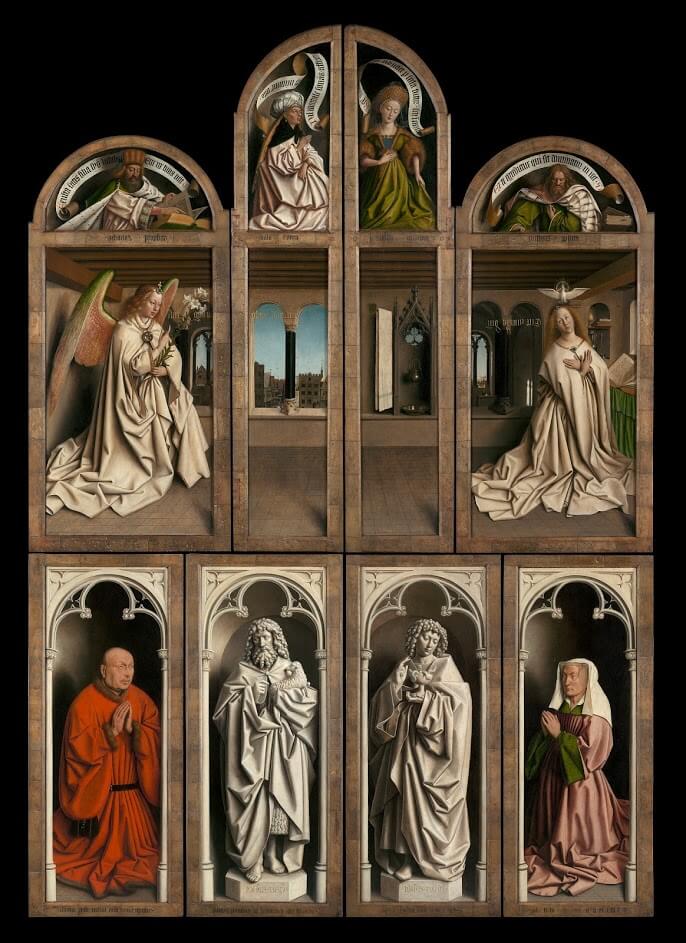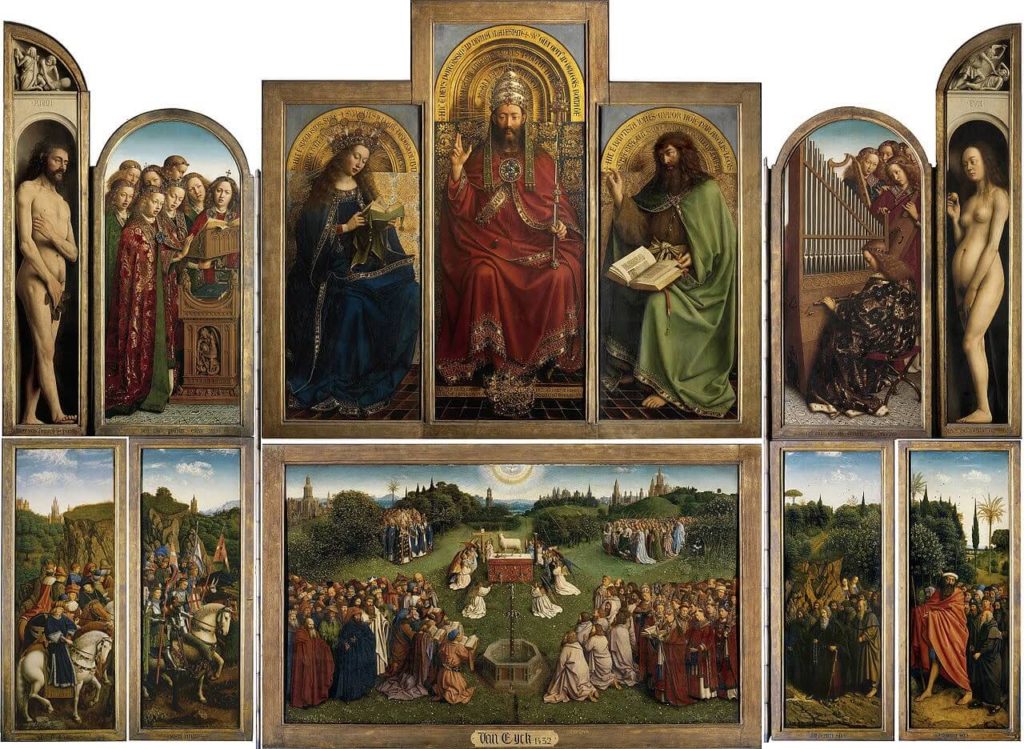After showing you some of the permanent museum collections and some of the most famous art pieces in the world. I thought it would be nice to take you to one of the most special temporary exhibitions organised this year.
2020 is dedicated to one of the most famous Belgian artists, Jan van Eyck. And, the Museum of Fine Arts in Ghent organised the most significant exhibition ever about that artist.
Unfortunately, we can’t visit it in a moment. That’s why I’m taking you to a virtual museum visit to Jan van Eyck’s and An Optical Revolution exhibition at MSK in Ghent.
Jan van Eyck: Exhibition at MSK in Ghent
I was lucky enough to visit Jan van Eyck: An Optical Revolution exhibition organised in Ghent just before all the museums in Belgium shut down.
It’s the biggest exhibition ever organised to celebrate this amazing Belgian master. And to honour him even more, his most famous work, the Ghent Altarpiece was thoroughly restored.
TIP: I’ve made a video about Jan van Eyck and An Optical Revolution exhibition at MSK in Ghent. You can watch it here:
Who was Jan van Eyck?
But, let me start by telling you more about this fantastic painter first. Who was Jan van Eyck? And why was he so important for the art world?
Jan wan Eyck was born around 1390 and died in 1441. Born close to Liège in today’s Belgium, he then lived and worked in Den Haag (NL), Lille (FR) and Bruges (BE).
⤷ Read more about Jan van Eyck in Bruges in my blog post here
He was exceptionally well educated for his time. Van Eyck spoke Latin, and also used Greek and Hebrew alphabets in his inscriptions. He was also one of the first painters ever who was signing his work. He was signing it as ‘I, Jan van Eyck, was here!’
Probably both because of his education and a great artistic talent, he became interesting to the Burgundian duke, Philip the Good. Van Eyck painted for Philip the Good, his court and wealthy citizens of Bruges and Ghent.
However, it looks like he wasn’t only Philip’s court painter. He took several diplomatic visits abroad on his behalf. They are described as ‘secret missions’ in documents, and although he was paid a lot for those trips, their exact nature is still unknown.
He went to Lisbon in 1428 to explore the possibility of a marriage contract between the duke and Isabela of Portugal. One of his tasks during it was to paint a portrait of Isabela, so the duke would know how his future wife looks like.
An Optical Revolution Exhibition at MSK in Ghent
This year is dedicated to Van Eyck and to celebrate his work, the Museum of Fine Arts (MSK) in Ghent organised the biggest ever exhibition about him.
Around 23 of Van Eyck’s artworks are preserved. And you can see more than a half, some 13 pieces that travelled from all over the world, at this exhibition.
Its star is the Ghent Altarpiece, displayed for the first, and probably the last, time outside the Saint Bavo Cathedral in Ghent.
It’s so interesting to see all those paintings in one place. From the religious art to some of the portraits, you can see quite well why he’s considered to be one of the most important painters of all times.
How Van Eyck revolutionised the art world?
Jan van Eyck revolutionised painting world and brought the Renaissance to the north of Europe. In the same time, he inspired and influenced many of his Italian contemporaries.
You can see that painting revolution so well at this exhibition.
1/ Oil-painting
Oil painting before Jan van Eyck was an impractical technique. It would take a long time for the oil to dry, and the painter would need to wait quite some time to apply the next layer of paint.
However, van Eyck started experimenting with that technique to improve it. After making numerous tests, he’s adding so-called drying agents and managed to shorten the drying period that way.
He could paint quickly and easily apply layer after layer of paint.
Van Eyck actually improved it so well, that a hundred years later, a famous Italian artist’s biographer Giorgio Vasari, attributed the discovery of oil paint to him.
2/ Realism & Details
Jan van Eyck was observing the world around him in a completely new way. His focus on details was previously unseen.
The realism he’s showing on his paintings isn’t visible in details only. But, also in a way, he’s showing the volume of human figure and depth of space by the way he’s presenting light and shadow on his paintings.
Van Eyck’s Portraits
That’s especially visible in his portraits where you can see a big contrast between illuminated faces and dark black backgrounds.
His portraits are among the first that weren’t showing royals or aristocrats.
Van Eyck is always following the same formula when it comes to portraits:
- The three-quarter profile
- Focus on details on a person’s face
- Contrast between the darker background and the illuminated face
3/ Light
Although he was using the light to show the volume, he’s taking a step further in the way of showing the light in his paintings.
That’s very well visible on the Ghent Altarpiece. He’s painting the actual light of the chapel in Saint Bavo Cathedral in which he knew altarpiece was going to be installed.
That way it seems as the exterior panels are actually illuminated by light that enters the chapel from the right.
Jan van Eyck & the Ghent Altarpiece
Ghent Altarpiece, painted by Jan and his brother Hubert van Eyck, became a symbol of this Belgian town. It’s located in Saint Bavo Cathedral since 1432 when it was installed there.
Ghent Altarpiece panels at the Van Eyck exhibition in MSK
However, an extensive restoration started in 2012, and it was finished a few months ago. For that occasion, the exterior panels of the Altarpiece, and the ones with Adam and Eve, are displayed for the first time in history outside of it.
They are the central pieces of the ‘Jan van Eyck. An optical revolution’ exhibition at the nearby Museum of Fine Arts in Ghent. It’s a unique chance to see them from close and look at all the small details that otherwise couldn’t be seen.
Closed Ghent Altarpiece:
Ghent Altarpiece at the Cathedral of Saint Bavo in Ghent
Ghent altarpiece consists of 24 panels painted on oak wood. The most famous pieces are the central Adoration of the Mystic Lamb, Adam and Eve and, probably my favourite, the Singing Angels.
TIP: Watch my video above for the full explanation about the Ghent Altarpiece, how it looks when open or closed and all the panels
Exterior panels of the Altarpiece are just temporarily displayed at the exhibition at MSK in Ghent. However, once it is over, you could see the whole Ghent Altarpiece at the Cathedral once again.
Open Ghent Altarpiece:
Jan van Eyck is absolutely one of the most important painters of all times. And the one who brought an optical revolution to the painting of the early Renaissance in the north of Europe.
Hope you enjoyed in this virtual museum visit to Jan van Eyck exhibition at MSK in Ghent. Do you have any questions? Ask them in comments and I’ll answer them!
Would you like to see my previous virtual museum visits?
Johannes Vermeer at the Rijksmuseum
Claude Monet & The Water Lilies
*Many thanks to Visit Flanders for providing me with some photos for this blog post.


